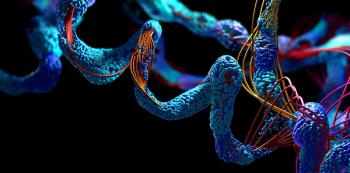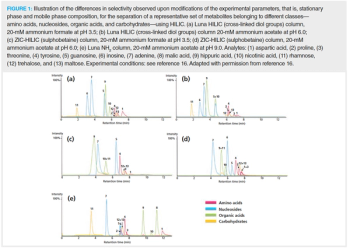
The Chromatographic Society will honor five scientists and academics next year, conferring its highest honor, the Martin Medal, to David McCalley and Fabrice Gritti.

The Chromatographic Society will honor five scientists and academics next year, conferring its highest honor, the Martin Medal, to David McCalley and Fabrice Gritti.

A comprehensive analytical approach utilizing online two-dimensional liquid chromatography coupled with hybrid linear ion trap orbital trap mass spectrometry, has enabled the in-depth analysis of Huangqi Guizhi Wuwu decoction, identifying 170 chemical constituents and offering insights into its complex chemical composition and potential therapeutic properties.

This instalment of “Column Watch” presents many of the highlighted topics and trends observed at this exceptionally well-run symposium.

Increases and decreases in anthocyanin concentration, which relates to the level of sugars found in red wine, were observed at specific weekly intervals of the grape ripening process.

An overview of different approaches for the qualitative and quantitative analysis of polysorbates.

A team of researchers has investigated strategies to overcome sample introduction challenges in hydrophilic-interaction chromatography (HILIC). By employing techniques such as pre-column dilution and selecting alternative organic solvents, they successfully addressed the issues related to injection solvent strength, resulting in improved peak symmetry and separation efficiency in HILIC analyses.

In a presentation at HPLC 2023, Kevin Pagel of Freie Universität in Berlin, Germany described methods he has found most effective for better understanding the roles of glycans and glycoconjugates in biological processes.

Davy Guillarme of the University of Geneva said in a talk at HPLC 2023 that short columns have shown promise, but ultrahigh-performance liquid chromatography (UHPLC) instrumentation is not yet optimized to realize their benefits.

In a session on omics at HPLC 2023, Robert T. Kennedy of the University of Michigan revealed how scientists are taking advantage of new developments and cutting down on analysis time.

Fresh garlic and aged garlic, both brown and black, were all analyzed for their bioactives, in an attempt to expand those compounds’ applications as food ingredients and dietary supplements.

Adjustable polyacrylamide stationary phases developed by researchers enhance separation performance in liquid chromatography, according to a recent publication. The study demonstrates the synthesis of vinyl modified silica and the successful preparation of polyacrylamide modified silica (PAM-SIL) stationary phases, allowing for fine control of separation performance.

The latest research news and news in brief.

Researchers have developed polyacrylamide hydrophilic stationary phases with adjustable performance. The innovative approach allows for customized separation capabilities, enhancing the efficiency and versatility of chromatographic techniques. The findings open up new possibilities for natural product chemistry and pharmaceutical research.

We interviewed an AI program (ChatGPT) for LCGC North America asking questions about AI and its role in various applications for separation science to include data analysis, and high performance liquid chromatography (HPLC), hydrophilic-interaction chromatography (HILIC), reversed-phase liquid chromatography (RPLC), liquid chromatography–mass spectrometry (LC–MS), gas chromatography–mass spectrometry (GC–MS), high resolution mass spectrometry (HRIM–MS), high resolution tandem mass spectrometry (HRMS/MS), and related topics.

The evolution of biomolecule analysis is discussed in this article.

A rapid and robust LC–MS/MS method for determining lactulose and rhamnose concentrations in blood plasma was used to determine intestinal permeability from blood plasma, which can help diagnose gastrointestinal diseases such as Crohn’s disease.

A new study has reported the preparation, characterization, and chromatographic evaluation of a nickel oxide deposited silica stationary phase in HILIC, which exhibited multiple retention mechanisms and enhanced chromatographic selectivity for analytes.

The study highlights the importance of developing new chromatographic methods for the analysis of ionizable compounds, such as BAK, and the potential of mixed-mode chromatography for pharmaceutical applications.

In this LCGC blog, we reflect on the movement to make analytical chemistry more environmentally friendly, and how to potentially better those efforts for the industry's future.


This review article discusses the novel separation and detection strategies that are considered promising in clinical metabolomics to enhance the metabolome coverage. It includes hydrophilic interaction chromatography (HILIC), supercritical fluid chromatography (SFC), multidimensional LC approaches, as well as ion-mobility mass spectrometry (IM-MS) and data-independent acquisition (DIA) analysis methods.

This article is an update on the technique of HILIC and covers recent ideas on the mechanism of separation, and how it may be manipulated to suit the separation of particular sample types. The advantages of HILIC are discussed, and also the actual and perceived disadvantages of the technique and how the latter can be overcome. Some new applications of HILIC for characterization of biopharmaceuticals, where it can even be applied to the separation of intact proteins, and to applications in metabolomics, will be discussed.

The Column spoke to Steven Janvier, a PhD student at Sciensano and Ghent University (Belgium), and Celine Vanhee, a scientist at Sciensano, about their work to develop a hydrophilic interaction chromatography (HILIC) methodology capable of detecting counterfeit polar peptide drugs available on the black market.

The Column spoke to Núria Fontanals, a senior researcher at the Department of Analytical and Organic Chemistry, Universitat Rovira i Virgili, Spain, about her work investigating the impact of artificial sweeteners as environmental pollutants using hydrophilic interaction chromatography (HILIC) and the broader role of HILIC in environmental analysis.

Certain details related to mobile-phase preparation that can be assumed in reversed-phase LC separations can be much more consequential in HILIC.